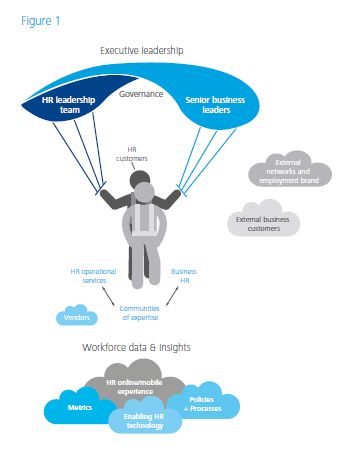HR has a mission: to be 'high impact'. A new operating model for HR is emerging
What is holding HR back from making the impact the business expects? Three main factors have come out of research carried out by Bersin by Deloitte and our experiences with complex clients in the field:
- The traditional definition of the business HR role no longer meets the business and workforce challenges of the 21st century. Business leaders and sometimes the HR function itself have a dated view of HR's strategic and business potential
- Business HR roles have often been left to evolve organically in the hope of becoming more strategic merely by centralising some activities within a traditional HR administrative group and implementing HR technology. Changes of this nature, or the use of titles such as HR Business Partner have not provided business HR teams with the tools, training or infrastructure to attain the elusive goal of 'getting strategic'
- Specifically in Luxembourg, the typically small size of organisations means that local administrative roles are combined with a more strategic role, which further undermines the job content of the business HR professional.
Despite the best of intentions, in many organisations today's HR 'business partners' are yesterday's 'generalists', without much more than a new title, some new automation, and the removal of some administrative work. HR leaders tell us they still find it difficult to drive new outcomes when the HR professionals closest to the business are still doing the same things as before.
One of the major shifts involved in implementing the Deloitte High-Impact HR (HIHR) Operating Model is taking the role of business HR to the next level— creating expert consultants close to the business. Yet, despite the widespread adoption of a business-focused HR role, organisations indicate that they are not achieving the anticipated impact and return on investment from the change. In fact, a large portion of the HR work continues to be administrative and transactional in nature.
The HIHR Operating Model places HR customers in the centre, with business HR positioned closest to the customer to drive strategic business objectives and enhance business performance by working in partnership with leaders of people and the business, applying increased HR agility, flexibility, coordination, networking and alignment.

Business HR roles
New era. New challenges. New business HR role.
Two significant changes differentiate the role of business HR in the High-Impact model:
-
First, business HR roles must operate day-to-day as part of the business leadership team and take responsibility for driving and owning business outcomes (Figure 2)
In earlier models, the HR business partner was designed and positioned to be an 'outside' role looking to 'partner' with the business. In High- Impact HR, business HR roles are embedded within the business and work directly with line leaders. Business HR professionals are trained and rewarded to meet business objectives and work on the business agenda. They not only service the business, they also take ownership of real business issues as collaborative members of the business leadership team. In this way, they identify issues, diagnose root causes, provide insights, offer recommendations and deliver solutions to solve some of the most pressing business objectives through the talent lens. Their focus on the business-specific people challenges in the organisation creates a healthy tension or balance between them and the objectives and roles of the HR 'communities of expertise', which push a more standardised, company-wide agenda
- Second, achieving High-Impact HR through business HR roles requires a continuum of business HR roles, thinking more broadly than in the past. Some models suggest establishing 'HR business partners' as the one role that services the business. Our research and experience shows that actually there are two: one to operate on a strategic level and another to operate as an advisor tasked with designing and implementing solutions, collaborating with HR shared services and other specialists available.
To read this article in full, please click here.
The content of this article is intended to provide a general guide to the subject matter. Specialist advice should be sought about your specific circumstances.



